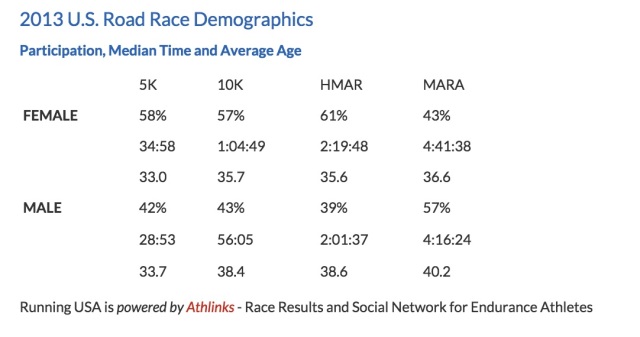 Admit it. You like to compare yourself to other runners. These stats from a 2013 RunningUSA study on participation, median time and average age certainly present some numbers for comparison’s sake.
Admit it. You like to compare yourself to other runners. These stats from a 2013 RunningUSA study on participation, median time and average age certainly present some numbers for comparison’s sake.
The demographics are interesting. Women dominate participation at the 5K distance, 58% to 42% over men.
At the 10K level, the ratios are about the same with 57% women and 43% men.
At the Half Marathon distance, the numbers skew even further however. 61% women and 39% men.
But at the Marathon distance, the men outnumber the women 57% to 43%.
As of 2013, women outnumber men in the sport. That was a big flip in perception when it happened back in 2010.
Interestingly, while women outnumber men in participation, and there are plenty of women who beat men in races, there are still median time differences in each of the typical levels of racing. In the 5K, the media time for women is 34:58 to the men at 28:53. That’s about a 20% difference.
The difference is markedly less at the 10K distance, where the difference between women and men is about 13%, which holds about true at the Half Marathon distance as well.
The gap drops considerably at the marathon level, where men outpace women by only 9% on median.
These numbers represent the general population.
World Class improvement
But how have world marathon times improved among men and women?
 In 1908 the world record marathon for men was 3:50. It is now 2:02:57 by Dennis Kimetto. That is a 31% improvement in 107 years.
In 1908 the world record marathon for men was 3:50. It is now 2:02:57 by Dennis Kimetto. That is a 31% improvement in 107 years.
In 1926, the women’s world record marathon was 3:40:22. It is now 2:15:25 by Paula Radcliffe. That is a 39% improvement in 99 years. However far less opportunities were accorded women to participate until the early 1970s, when women were finally allowed into major marathon races.
Only 43 years passed from 1970 when Caroline Walker ran 3:02:53 to 2003 when Radcliffe ran 2:15. That’s a 25% improvement.
By comparison, the men’s world record in 1969/70 was set by Derek Clayton at 2:08:33, which represents a 31% difference in best marathon times between women at the time, and men.
Women have since closed the gap by 20%, and that’s in just 40 years. Now the difference between the men’s world marathon best and the women’s world marathon record is about equivalent at the world class level as it is with the general population.
Closing in

Girls running programs such as this middle school team are helping the sport grow by increasing participation at a younger age.
Women have essentially had a shorter time frame in which to improve their times since the 1970s and 80s when participation was genuinely allowed and encouraged through Title IX and road races opening up to women competitors.
Thanks to those advances in culture, women runners now exceed those of men at all distances but the marathon. Interestingly, the time gap between the general/median population of runners and world class marathoners is both at 10%. The question is whether this time gap will continue to come down, or whether we’re seeing a genuine stall in the overall improvement of women runners?
Continuing improvement
Men’s world-best marathon times have improved two minutes from 2003 to 2014. Women’s times have not improved at all in that time period. Radcliffe’s record has looked out of reach for 10 years.
That has happened before for the men, as well. Interestingly, the last 10-year gap for improvement among was the period between 1935 (Son Kitei, Japan, 2:26) and 1947 when Suh Yun-Buk of Korea ran a disputed 2:25 on a potentially short, point-to-point course.
Then along came Jim Peters of the United Kingdom to drop the world’s best marathon time by five full minutes in 1952. He proceeded to lower the world best to 2:17 in the next three years.
These gaps and drops raise the interesting question whether women will again see a drop in times. Given the increased opportunites and increased participation in women’s runnings, the odds seem favorable to continued improvement.
 Currently the women’s world record pace is 5:10 per mile by Radcliffe. The men’s world record pace is just over 4:40 per mile. That’s a 30 second per mile difference.
Currently the women’s world record pace is 5:10 per mile by Radcliffe. The men’s world record pace is just over 4:40 per mile. That’s a 30 second per mile difference.
So while women have closed down the pace gap in a relative short time through increased participation opportunities and a continuing growth in the sport, there is still at least a 10% difference on average between women runners at both the median and world-class levels.

Tera Moody (center in black outfit) an Olympic Trials women’s marathoner, nearly stole away with the overall race victory at the 2015 Fox Valley Marathon in St. Charles, Illinois.
Interestingly, that difference is hardly evident in most races. Wherever women and men race together, the playing field is essentially, perceptually even. Relatively few men can beat the world’s best women runners.
For example, second place finisher in the Fox Valley Half-Marathon in 2015 was a runner named Tera Moody. She only lost to the first male by 15 seconds.
So the numbers tell an interesting story about men and women runners. But not the whole story. That remains to be written, and it’s why all of us can enjoy our time on the road together.
Source for marathon world bests: Wikipedia
Source for marathon pace charts: http://marathonpacechart.com/


